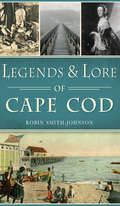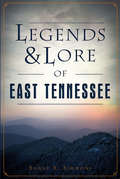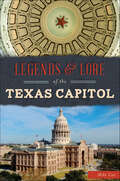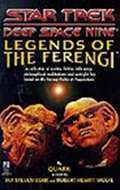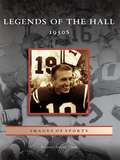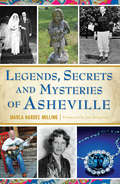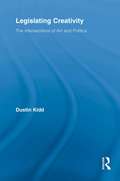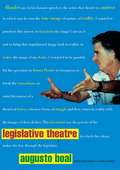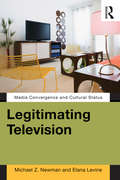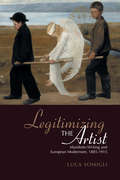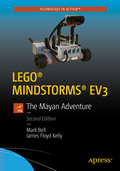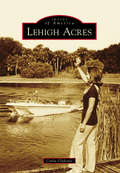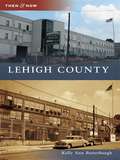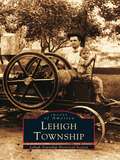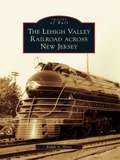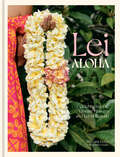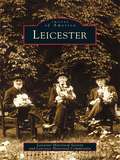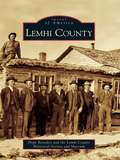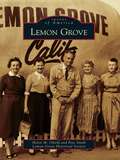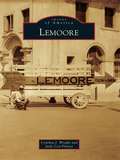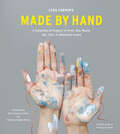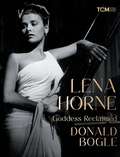- Table View
- List View
Legends & Lore of Cape Cod (American Legends)
by Robin Smith-JohnsonCape Cod has a rich tradition of local lore, stretching back to a time before the Pilgrims arrived. Ancient Wampanoag legends like Granny Squannit and Princess Scargo are as familiar as tales of pirates and explorers, including "Black Sam" Bellamy and Donald Baxter Macmillan. Felines often blocked "Cat's Alley" in pursuit of food from fishermen's boats. The remnants of Billingsgate Island can be seen at low tide, and visits from Jenny Lind and Helen Keller contrast with the mysterious stories of the "Lady of the Dunes" and New England's Dark Day. Author Robin Smith-Johnson shares historic tales of shipwrecks, murders, hauntings and more from the Cape.
Legends & Lore of East Tennessee (American Legends)
by Shane S. SimmonsThe mountains of East Tennessee are chock full of unique folklore passed down through generations. Locals spin age-old yarns of legends like Davy Crockett, Daniel Boone and Dragging Canoe. Stories of snake-handling churches and the myths behind the death crown superstitions dot the landscape. The mysteries surrounding the Sensabaugh Tunnel still haunt residents. Author Shane Simmons explores tales of bravery, lore and bizarre customs within the East Tennessee region.
Legends & Lore of the Texas Capitol (Landmarks)
by Mike CoxFrom its beginning as one of the most ambitious construction projects west of the Mississippi, the imposing red granite Lone Star statehouse loomed large in Texas lore. The iconic landmark rests on a foundation of election rigging, an unsolved murder, land swaps and pre-dedication blackmail. It bore witness to the first meeting between LBJ and Lady Bird, as well as a bizarre resolution honoring the Boston Strangler. Mike Cox digs up a quarry's worth of the capitol's untold history, cataloguing everything from its ghost stories to its public art and collectible tourist kitsch.
Legends of Hollywood Forever Cemetery
by E. J. Stephens Kim StephensFounded in 1899, scenic Hollywood Forever Cemetery—the only cemetery located within the city of Hollywood—serves as the “permanent home” for many of Hollywood’s most famous (and infamous) characters. Hollywood Forever Cemetery boasts a fascinating history surpassed only by the compelling stories of its famous residents. Behind its iron gates are the graves of Cecil B. DeMille, Rudolph Valentino, Douglas Fairbanks, Carl “Alfalfa” Switzer, Tyrone Power, Nelson Eddy, Marion Davies, Fay Wray, Mel Blanc, Johnny Ramone, Don Adams, Bebe Daniels, Bugsy Siegel, and a host of others whose memorials tell the history of Tinseltown in stone.
Legends of the Ferengi (Star Trek )
by Ira Steven Behr"Once you have their money, never give it back." -- #1 "Anything worth doing is worth doing for money." -- #13 For centuries these and the other famous Ferengi "Rules of Acquisition' have been the guiding principles of the galaxy's most successful entrepreneurs. But the wisdom behind them was not won without a high cost in lives and latnium. Now at last these inspiring tales of avaricious Ferengi wresting monetary gain from the jaws of poverty are available to the profit-hungry across the galaxy!
Legends of the Hall: 1950s (Images of Sports)
by Kristine Setting ClarkLegends of the Hall: 1950s captures a period of time when playing professional football was for tough, honest men who played solely for the love of the game. The 1950s was an era of crew cuts and nicknames like Crazylegs, Hopalong, and Night Train. The decade began with Sammy Baugh throwing his last passes and ended with the death of Bert Bell. This era also produced some of the greatest quarterbacks ever to play the game. They were known as the glamour boys of the league--Otto Graham, Bob Waterfield, Bobby Layne, Y. A. Tittle, and Bart Starr, to name a few. The incomparable, individual brilliance and unique team chemistry that marked this era have transcended this specific time and place to make Legends of the Hall: 1950s an unforgettable part of the magic and myth of professional football.
Legends, Secrets and Mysteries of Asheville
by Marla Hardee Milling Foreword By SchochetBeyond the beaten path of local landmarks, residents and tourists can find curious secrets, lost mysteries and fascinating legends. The famed Hope Diamond once found itself, and its mysterious curse, buried in an Asheville girl’s sandbox. Elvis once handed a cherished guitar to a local man at an Asheville concert, and he held on to it for forty years. At a flea market, an Asheville attorney paid a few bucks for an old tintype likely of Billy the Kid, and it may be worth millions. Native author Marla Hardee Milling recounts odd, but true, stories hiding behind Asheville’s picturesque beauty.
Legislating Creativity: The Intersections of Art and Politics (Routledge Advances in Sociology)
by Dustin KiddHow does political policy-making shape the creative activities of artists? Do the political interests of artists influence actual political practices in any way? Legislating Creativity examines the relationship between art and politics through an analysis of controversial art projects tied to the National Endowment for the Arts during the Culture Wars (late 1980s-1990s). Though there have always been tensions in government funding for the arts, these controversies intensified the public debates surrounding art/politics and remain as a focal point in conversations that continue today. The book focuses on three case studies: Mapplethorpe's controversial photography, an exhibit on the impact of AIDS entitled Witnesses, and the Guerrilla Girls. Dustin Kidd has provided a thoroughly enriching look at the intersections of art and politics—the ways that political practices transform creative expression and the ways that artistic drives shape political policies.
Legislative Theatre: Using Performance to Make Politics (Augusto Boal)
by Augusto BoalAugusto Boal's reputation is now moving beyond the realms of theatre and drama therapy, bringing him to the attention of a wider public. Legislative Theatre is the latest and most remarkable stage in his work. 'Legislative Theatre' is an attempt to use Boal's method of 'Forum Theatre' within a political system to create a truer form of democracy. It is an extraordinary experiment in the potential of theatre to affect social change. At the heart of his method of Forum Theatre is the dual meaning of the verb 'to act': to perform and to take action. Forum Theatre invites members of the audience to take the stage and decide the outcome, becoming an integral part of the performance. As a politician in his native Rio de Janeiro, Boal used Forum Theatre to motivate the local populace in generating relevant legislation. In Legislative Theatre Boal creates new, theatrical, and truly revolutionary ways of involving everyone in the democratic process. This book includes: * a full explanation of the genesis and principles of Legislative Theatre * a description of the process in operation in Rio * Boal's essays, speeches and lectures on popular theatre, Paolo Freire, cultural activism, the point of playwrighting, and much else besides.
Legitimating Television: Media Convergence and Cultural Status
by Elana Levine Michael Z NewmanLegitimating Television: Media Convergence and Cultural Status explores how and why television is gaining a new level of cultural respectability in the 21st century. Once looked down upon as a "plug-in drug" offering little redeeming social or artistic value, television is now said to be in a creative renaissance, with critics hailing the rise of Quality series such as Mad Men and 30 Rock. Likewise, DVDs and DVRs, web video, HDTV, and mobile devices have shifted the longstanding conception of television as a household appliance toward a new understanding of TV as a sophisticated, high-tech gadget. Newman and Levine argue that television’s growing prestige emerges alongside the convergence of media at technological, industrial, and experiential levels. Television is permitted to rise in respectability once it is connected to more highly valued media and audiences. Legitimation works by denigrating "ordinary" television associated with the past, distancing the television of the present from the feminized and mass audiences assumed to be inherent to the "old" TV. It is no coincidence that the most validated programming and technologies of the convergence era are associated with a more privileged viewership. The legitimation of television articulates the medium with the masculine over the feminine, the elite over the mass, reinforcing cultural hierarchies that have long perpetuated inequalities of gender and class. Legitimating Television urges readers to move beyond the question of taste—whether TV is "good" or "bad"—and to focus instead on the cultural, political, and economic issues at stake in television’s transformation in the digital age.
Legitimizing the Artist
by Luca SomigliIn the late nineteenth and early twentieth centuries, the production of literary and cultural manifestoes enjoyed a veritable boom and accompanied the rise of many avant-garde movements. Legitimizing the Artist considers this phenomenon as a response to a more general crisis of legitimation that artists had been struggling with for decades. The crucial question for artists, confronted by the conservative values of the dominant bourgeoisie and the economic logic of triumphant capitalism, was how to justify their work in terms that did not reduce art to a mere commodity.In this work Luca Somigli discusses several European artistic movements - decadentism, Italian futurism, vorticism, and imagism - and argues for the centrality of the works of F.T. Marinetti in the transition from a fin de siécle decadent poetics, exemplified by the manifestoes of Anatole Baju, to a properly avant-garde project aiming at a complete renewal of the process of literary communication and the abolition of the difference between producer and consumer. It is to this challenge that the English avant-garde artists, and Ezra Pound in particular, responded with their more polemical pieces. Somigli suggests that this debate allows us to rethink the relationship between modernism and post-modernism as complementary ways of engaging the loss of an organic relationship between the artist and his social environment.
Lego® Mindstorms® Ev3
by James Floyd Kelly Mark BellEV3 without limits! Build 5 amazing robotics projects that take DIY to a whole new level! You can do way more with your LEGO Mindstorms EV3 kit than anyone ever told you! In this full-color, step-by-step tutorial, top-maker and best-selling author John Baichtal shows you how to transcend Mindstorms' limits as you build five cutting-edge robotics projects. You'll discover just how much you can do with only the parts that came with your kit-and how much farther you can go with extremely low-cost add-ons like Arduino and Raspberry Pi. You'll learn how to reprogram your Mindstorms Intelligent Brick to add additional hardware options and create more complex programs. Hundreds of full-color, step-by-step photos teach you every step, every skill. Whenever you're ready for advanced techniques, Baichtal explains them in plain English. Here's just some of what you'll learn how to do: Build a drawing Plotter Bot that gyrates to draw new patterns Hack Mindstorms' wires-and control robots without wires Create a remote-controlled crane, and operate it from your smartphone Use the EV3 brick to control third-party electronic modules of all kinds Replace the EV3 brick with smarter, more flexible Arduino, Raspberry Pi, or BeagleBone Black hardware Build a robotic flower whose petals open and close based on time of day Use third-party sensors to build robots that can sense practically anything Load an alternate operating system onto your EV3 brick 3D print, laser, and mill your own perfect LEGO parts Create ball contraptions, and extend them with your own custom parts Make a pole-climbing robot-and hook up an altimeter to track its height This book is not authorized or endorsed by the LEGO#65533; Group. Register Your Book at www. quepublishing. com/register and receive 35% off your next purchase.
Lehigh Acres
by Carla UlakovicLehigh Acres emerged from an expanse of southwest Florida's wild lands due to the vision of industrialist, inventor, and self-made millionaire Leonard Lee Ratner and his business partners in the Lee County Land and Title Company. For Ratner, southwest Florida represented a land of opportunity. In 1952, he purchased Lucky Lee Ranch in eastern Lee County as a means to maintain his fortune; however, a chance meeting in Miami with Gerald Gould, a young advertising executive, forever changed the future of this Florida ranchland. They formed a company, began subdividing the land, and devised a marketing plan to attract buyers from the Midwest and Northeast by selling dreams in "a golden land of opportunity" and touting an average temperature of 74 degrees. Soon, roadways, model homes, the Lehigh Acres Country Club and Motel, and an ultramodern auditorium brought the community to life. As the decades moved on, the company's holdings grew to 60,000 acres, making Lehigh Acres one of the largest subdivided communities in the nation. Rich in natural beauty, amenities, and activities, the dynamic marketing team convincingly sold many on the idea "that you needn't be a millionaire to live like one" in Lehigh Acres.
Lehigh County (Then and Now)
by Kelly Ann ButterbaughLehigh County has transformed throughout the years and now is a far cry from its rural identity only 50 years ago. Today Lehigh County is known as an important link to the metropolitan areas of New York City and Philadelphia.
Lehigh Township (Images of America)
by Lehigh Township Historical SocietyLehigh Township was settled in the late 1700s by immigrants who had come to work in the numerous slate quarries. Situated in the foothills of the Blue Mountains, the township represented the last signs of civilization for those traveling north from Philadelphia to the wilderness beyond the Lehigh Gap. The township has remained largely rural, with farms and open fields abundant along its two-lane highways.Compiled by members and friends of the Lehigh Township Historical Society, Lehigh Township is a collection of rare vintage photographs of the community. The Cherryville Hotel (which in its heyday was known throughout the area as one of the best places to get Pennsylvania Dutch food), local quarries, one-room schoolhouses, Dieter's Foundry, and the Indian Trail and Edgemont amusement parks make up a sampling of the countless familiar images of Lehigh Township's past. Lehigh Township is an indispensable reference for both residents and visitors.
Lehigh Valley Railroad across New Jersey, The (Images of Rail)
by Ralph A. HeissConstructed as the Easton and Amboy Railroad and opened by 1875, the Lehigh Valley Railroad was instrumental in developing the commerce and communities of central New Jersey through which it once ran. Originally built to haul unending trains of "black diamonds" from Pennsylvania to Perth Amboy, the Lehigh Valley Railroad became so much more than a conduit for shipping coal. In building across the state, it became instrumental in not only hauling produce to New York City markets but also for providing service to companies like Johns-Manville and Lionel Trains. From Phillipsburg to Jersey City and all points in between, the Lehigh Valley Railroad hauled freight and passengers, while at the same time contributing to the social fabric of the area. The Lehigh Valley Railroad across New Jersey paints a picture of a railroad that provided over 100 years of quality service to the Garden State.
Lehmputze und ihre Anwendungen (essentials)
by Dietmar SchäferDas Buch beschäftigt sich mit dem Lehmputz und der Technologie des Lehmputzes in Europa. Es werden Gemeinsamkeiten und Unterschiede der jeweiligen Lehmputztechnologien aufgezeigt.
Lehrbuch der Bauphysik: Wärme – Feuchte – Klima – Schall – Licht – Brand
by Peter Häupl Wolfgang M. Willems Martin Homann Christian Kölzow Olaf Riese Anton Maas Gerrit Höfker Christian NockeDas bewährte Lehr- und Nachschlagewerk der Bauphysik wurde für die 9. Auflage aktualisiert und moderat ergänzt; neben einer Berücksichtigung der aktuellen normativen Situation ist hier insbesondere die Umstellung auf das Gebäudeenergiegesetz (GEG 2020) zu nennen. Das Lehrbuch der Bauphysik beinhaltet damit in konzentrierter Form den heutigen Stand der Technik in diesem Bereich. Um dem Anspruch eines Studientitels auch weiterhin gerecht zu werden, wurden die Ausführungen zu den unterschiedlichen Themenbereichen auf die Lehrpläne im Fach Bauphysik abgestimmt und – wo es zielführend erschien – vertieft und ergänzt. Neben den wissenschaftlichen Grundlagen und Zusammenhängen sind im Hinblick auf die praktische Anwendung die Inhalte der wesentlichen bauphysikalisch relevanten Normen und Verordnungen in komprimierter Form enthalten.
Lei Aloha: Celebrating the Vibrant Flowers and Lei of Hawai'i
by Meleana EstesExplore Hawaiian culture through the art of lei making with flower inspirations and gorgeous photography from stylist, fashion designer, and local island icon Meleana Estes.Brimming with vibrant photos of the most famous flower garlands of Hawai&’i—the lei—in dreamy island settings, Lei Aloha tells the story of the flowers, craftsmanship, and community of lei culture, offering a window into this beautiful world where life is a little slower, flowers are abundant, and personal connections run deep. Local style icon Meleana Estes continues the legacy of her native Hawaiian grandmother, who was well known for her intricate and stunning lei. Sprinkled throughout the book also are anecdotes about the fascinating history of flowers, lei, and island traditions.Each chapter tells the story of a grouping of flowers and lei, such as plumerias for a sweet gathering of neighborhood keiki (kids), elegant strands of white and yellow ginger for a candle-lit party, or striking lei haku made for hula performances. It&’s an easy craft for the homesteader with roots in a full backyard garden or the digital nomad who keeps her possessions in one suitcase and can pick up flowers on her travels. With evocative photos of vintage mu&’umu&’us, lush tropical gardens, lei-bedecked longboard surfers, striking tablescapes, and graceful hula dancers, Lei Aloha shares a side of the islands that only locals usually get to see.
Leicester
by Leicester Historical Society Leicester Historical CommissionLeicester began as a small Colonial settlement in the early 1700s and quickly blossomed into a flourishing farming community. Located among the headwaters of the Blackstone River, the numerous villages of Leicester prospered during the Industrial Revolution with gristmills, sawmills, and textile mills. By the 1880s, one-third of all hand and machine cards made in North America were produced in Leicester. After the deindustrialization of the twentieth century, the town began to return to its agricultural roots; today, for the most part, it appears largely rural once again. Leicester pays tribute to the industrial, yet rural, and independent, yet cooperative, spirit of this suburb of Worcester.
Lemhi County
by Hope Benedict Lemhi County Historical Society and MuseumSituated at the base of the Continental Divide and surrounded by the Lemhi and Salmon River Ranges, Lemhi County, Idaho, provides a fascinating look at the "Old West" as it makes its precarious transition to a new order. Traditional homeland to the people of Sacajawea, Lemhi County became a destination point for Lewis and Clark as they worked their way across the continent, for trappers, for missionaries, and finally, in 1866, for prospectors and those who kept them fed, clothed, and entertained. The community that developed in the valleys of the Salmon, Lemhi, and Pahsimeroi Rivers benefited from long-term mining and the simultaneous evolution of ranching and the timber industry, and this growth was well documented by local photographers.
Lemon Grove: Lemon Grove's Ace Drive-in, A Symbol Of Its Time (Images of America)
by Helen M. Ofield Lemon Grove Historical Society Pete SmithLemon Grove dates to 1892 when it first appeared in the San Diego County records as "Lemon Grove." The tiny, whistle-stop town emerged during the "second gold rush," the rise of California's citrus industry, which was facilitated by the 1849 Gold Rush, the break up of the Mexican ranchos in Alta California, and the advent of statehood for California in 1850. Land speculators poured into California, lured by the exquisite climate, five growing seasons, and the possibilities for success in agriculture and business. Lemon Grove became home to gentlemen farmers from the East and Midwest, whose descendants live on in the community to this day.
Lemoore
by Judy Cox-Finney Cynthia J. WrightThe Tachi-Yokut Indians made a subsistence living around the great inland sea known as Tulare Lake, near present-day Lemoore, long before Dr. Laverne Lee Moore came to town in 1871. Still before Moore came other Anglo settlers. The Rhoads family settled and built an adobe house, which remains today, where Daniel and Sarah Rhoads raised a family, ranched, and did business in 1856. Rhoads was part of the group that rescued the ill-fated Donner party. The U.S. Post Office saw fit to name the town after its founder. During World War II, Lemoore was the site of a U.S. Army Air Force training camp. Since 1963, it has been home to one of the largest inland U.S. air bases: Naval Air Station Lemoore.
Lena Corwin's Made by Hand: A Collection of Projects to Print, Sew, Weave, Dye, Knit, or Otherwise Create
by Lena Corwin“Opens up possibilities for dozens of skills, from printing to origami, from soap-making to patchwork; tie-dying, weaving, embroidery, and more.” —Foreword ReviewsIn 2009, tastemaker and bestselling author Lena Corwin turned the top floor of her Brooklyn brownstone into a studio and began hosting classes for local crafters. In Lena Corwin’s Made by Hand, she recreates and builds upon her popular workshop series in order to reach crafters in Brooklyn and beyond. For this “best of” collection, she has chosen expert teachers and her favorite projects: Jenny Gordy introduces us to knitted socks and elegantly sewn tops and dresses; Cal Patch teaches how to make a modern embroidery sampler as well as a braided rag rug; and Corwin herself presents her favorite screen-printing and stamping techniques. There are many lessons/projects, all presented with step-by-step photos and illustrations. Notice: For usability reasons, the digital edition of this book does not include all of the images found in the physical edition.“Made by Hand introduces readers to ageless crafting techniques with modern projects.” —HGTV.com“Like a private studio class . . . this book is a breath of fresh air.” —Examiner.com“A must-have for anyone who wants to create unique décor.” —Decorating Shortcuts“The 385 detailed illustrations, along with excellent step-by-step photographs and clear instructions, make each project tempting and approachable.” —Studios magazine“Those messy hands alone are inspiring me to get creative.” —Modern Eve“I got a sneak peek at a mostly lovely book. I can’t contain my excitement over this book. The projects are varied and so much fun.” —The Stylish Nest
Lena Horne: Goddess Reclaimed (Turner Classic Movies)
by Donald BogleFrom Donald Bogle, the award-winning author of Hollywood Black and leading authority on Black cinema history, this is a first-of-its-kind comprehensive and lavish biography of Hollywood&’s first African American movie goddess. Lena Horne&’s life and career are truly remarkable in American film history. She was the first Black performer to become a true star—to receive the kind of glamour treatment at the fabled MGM that the studio had previously given to the likes of Greta Garbo, Jean Harlow, Lana Turner, and Ava Gardner. At the same time, Horne dealt with endless indignities, not the least of which was the fact that her roles in films was often as a musical performer, which allowed her numbers to be easily stripped out of films without affecting the narrative when played to audiences that would find her presence undesirable. At long last, Lena Horne: Goddess Reclaimed gives the star her due. Through a highly informed and insightful narrative based on interviews, press accounts, studio archives, and decades of research, the book sheds new light on the star's compelling life and complicated career: her activism; her accomplishments and heady triumphs in movies, television, and nightclubs as she broke down long-standing barriers for Black individuals—especially Black women—and her solemn, sometimes bitter disappointments, both professional and personal. Illustrated by stunning photos (some published for the first time), this is the ultimate book on the icon.
